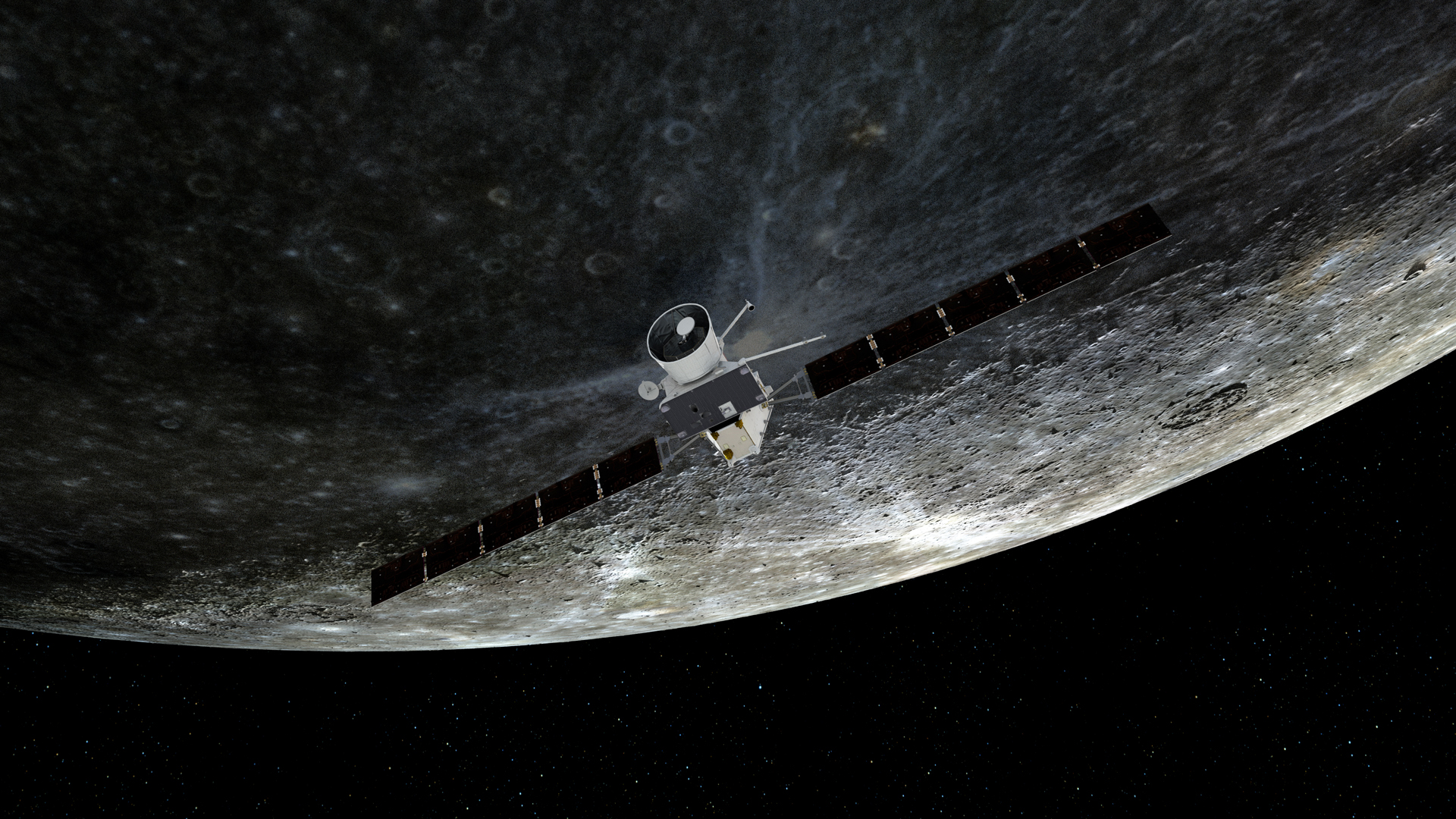Mercury-bound spacecraft whizzes past the smallest planet for the 2nd time
Reaching Mercury is notoriously difficult.

The Mercury-bound probe BepiColombo has taken its second look at its target planet today during a superclose flyby designed to slow the spacecraft down and adjust its trajectory.
BepiColombo is a joint mission by the European Space Agency (ESA) and the Japan Aerospace Exploration Agency (JAXA). The mission, consisting of two orbiters that travel to Mercury stacked on top of each other, launched into orbit around the sun in 2018. Since then, ground controllers have been adjusting the spacecraft's trajectory through a series of nine flyby maneuvers (one at Earth, two at Venus and six at Mercury itself), to gradually slow BepiColombo down so that it can enter orbit around the solar system's innermost planet in 2025.
The June 23 flyby was BepiColombo's second at Mercury, following the probe's first encounter with the planet in October 2021. The probe made its closest approach to Mercury's surface at 5:44 a.m. EDT (0944 GMT), when it passed only 125 miles (200 kilometers) from Mercury's crater-riddled surface, closer than the two orbiters will operate once the mission begins in earnest.
Related: Mercury looks stunning in this 1st flyby photo from Europe and Japan's BepiColombo mission
The probe was taking images of the scorched planet during the flyby with its low-resolution monitoring cameras that are mounted on the spacecraft's transfer module. ESA released the first image about four hours after the closest approach, revealing large impact craters including a 120-mile-wide (200 km) basin.
The two orbiters together carry 16 scientific instruments, but only about 60% of those were operational during the 48 hours around the closest approach, ESA's BepiColombo project scientist Johannes Benkhoff told Space.com in an email. The rest, including high-resolution cameras, cannot be operated in the cruise configuration, as they are hidden either by the spacecraft's transfer module or its sunshield.
Benkhoff said the spacecraft's magnetometers and particle detectors were switched on during the flyby and will likely generate valuable scientific data about the solar wind in Mercury's vicinity.
Get the Space.com Newsletter
Breaking space news, the latest updates on rocket launches, skywatching events and more!
During this flyby, BepiColombo approached Mercury from the night side, Benkhoff noted, which meant that imaging could only start 4 minutes after the closest approach, when the planet was sufficiently illuminated. By then, the probe was about 500 miles (800 km) away from Mercury's surface.
The images, which ESA plans to release within about a day, are expected to reveal craters and tectonic faults on Mercury's sunburnt surface.
"Even during fleeting flybys, these science 'grabs' are extremely valuable," Benkhoff said in an ESA statement. "We get to fly our world-class science laboratory through diverse and unexplored parts of Mercury's environment that we won't have access to once in orbit, while also getting a head start on preparations to make sure we will transition into the main science mission as quickly and smoothly as possible."
BepiColombo is only the second probe in history built to orbit Mercury, after NASA's Messenger mission, which studied the tiny rocky planet between 2011 and 2015. (Although in the 1970s, NASA's Mariner 10 made three flybys at Mercury while in orbit around the sun and took the first-ever images of the planet).
Mercury is a strange world where temperatures reach up to 800 degrees Fahrenheit (420 degrees Celsius) in the sun-exposed parts, but where, at the same time, scientists believe water ice lingers in permanently shadowed craters around the poles.
Mercury, while geologically dead at first glance, also shows hints of some form of tectonic activity, and sports a surprising magnetic field that scientists so far cannot fully explain. Many of these mysteries were uncovered by Messenger, and scientists hope that BepiColombo will provide the missing answers.

BepiColombo still has four flybys to go before finally settling into orbit around Mercury. The next flyby will happen about one year from now. In the meantime, next month, BepiColombo will make the closest approach to the sun of its whole mission.
Reaching Mercury is notoriously difficult, more difficult than reaching the distant giant planets Jupiter and Saturn. The reason for that is that the sun's gravity constantly accelerates any Mercury-bound probe, which needs to shed energy and speed — hence the long and winding journey of planetary flybys.
Follow Tereza Pultarova on Twitter @TerezaPultarova. Follow us on Twitter @Spacedotcom and on Facebook.
Join our Space Forums to keep talking space on the latest missions, night sky and more! And if you have a news tip, correction or comment, let us know at: community@space.com.

Tereza is a London-based science and technology journalist, aspiring fiction writer and amateur gymnast. Originally from Prague, the Czech Republic, she spent the first seven years of her career working as a reporter, script-writer and presenter for various TV programmes of the Czech Public Service Television. She later took a career break to pursue further education and added a Master's in Science from the International Space University, France, to her Bachelor's in Journalism and Master's in Cultural Anthropology from Prague's Charles University. She worked as a reporter at the Engineering and Technology magazine, freelanced for a range of publications including Live Science, Space.com, Professional Engineering, Via Satellite and Space News and served as a maternity cover science editor at the European Space Agency.









